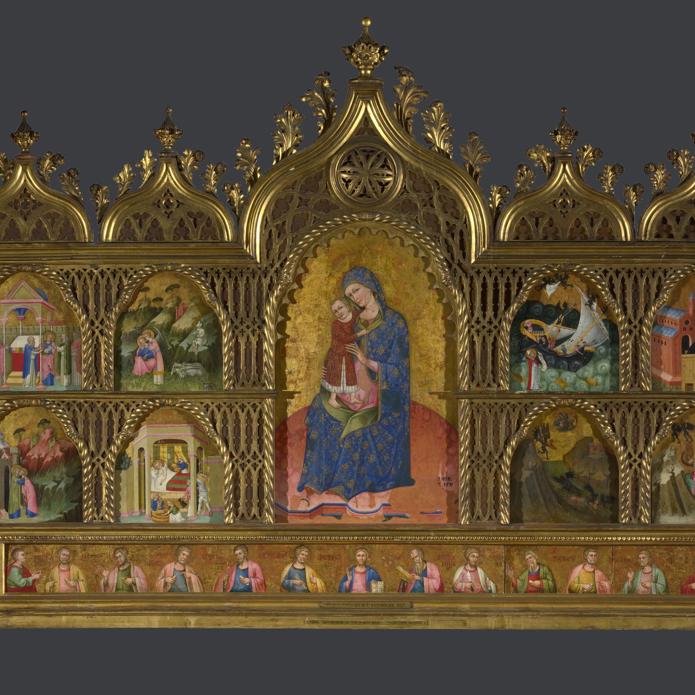Dalmatian/Venetian, 'The Virgin and Child', about 1400
About the work
Overview
The damaged inscription to the right of the Virgin describes her: Maria, mater humilitatis (‘Mary, mother of humility’). The so-called Virgin of Humility is usually shown, as here, seated on the ground, but with the Christ Child breastfeeeding. In Venice, a city with which this artist had close ties, the sunburst ‘brooch’ at the Virgin’s throat was a common feature in such paintings.
This image also includes a crescent moon at the Virgin’s feet, and 12 stars frame her figure. These symbols come from the Bible where the so-called Woman of the Apocalypse was ‘clothed with the sun, and the moon under her feet and upon her head a crown of 12 stars’ (Revelation 12: 12). They sometimes featured in images of the Virgin of Humility, especially in Venice. Later in the fifteenth century they became associated with the Immaculate Conception (the sinless conception of the Virgin Mary).
Key facts
Details
- Full title
- The Virgin and Child
- Artist
- Dalmatian/Venetian
- Part of the group
- Altarpiece of the Virgin Mary
- Date made
- about 1400
- Medium and support
- egg tempera on wood
- Dimensions
- 75 × 46.8 cm
- Inscription summary
- Inscribed
- Acquisition credit
- Bequeathed by H.E. Luxmoore, 1927
- Inventory number
- NG4250.1
- Location
- Not on display
- Collection
- Main Collection
- Previous owners
Provenance
Additional information
Text extracted from the ‘Provenance’ section of the catalogue entry in Dillian Gordon, ‘National Gallery Catalogues: The Italian Paintings before 1400’, London 2011; for further information, see the full catalogue entry.
Bibliography
-
1929National Gallery, National Gallery, Trafalgar Square: Catalogue, 86th edn, London 1929
-
1931L. Coletti, 'Sul polittico di Chioggia e su Giovanni da Bologna', L'arte, XXXIV/2, 1931, pp. 131-43
-
1936M. Meiss, 'The Madonna of Humility', Art Bulletin, XVIII/4, 1936, pp. 435-64
-
1946R. Longhi, Viatico per cinque secoli di pittura veneziana, Florence 1946
-
1947P. Hendy, An Exhibition of Cleaned Pictures of 1947: (1936-1947), London 1947
-
1950R. Pallucchini, 'Commento alla Mostra di Ancona', Arte veneta, IV, 1950, pp. 7-32
-
1951Davies, Martin, National Gallery Catalogues: The Earlier Italian Schools, London 1951
-
1951F. Bologna, 'Contributi allo studio della pittura veneziana del Trecento', Arte veneta, V, 1951, pp. 21-31
-
1964R. Pallucchini, La pittura veneziana del Trecento, Venice 1964
-
1978R. Longhi, Ricerche sulla pittura veneta: 1946-1969, Florence 1978
-
1979H.S. Ettlinger, 'The Iconography of the Columns in Titian's Pesaro Altarpiece', Art Bulletin, LXI/1, 1979, pp. 59-67
-
1983I. Petricioli, Tragom srednjovjekovnih umjetnika, Zagreb 1983
-
1983K. Prijatelj, Dalmatian Painting of the 15th and 16th Centuries, Zagreb 1983
-
1984I. Petricioli, 'Fermo e Zara: Contratti artistici tra Medioevo e Rinascimento', Notizie da Palazzo Albani, XIII/2, 1984, pp. 7-16
-
1986Davies, Martin, National Gallery Catalogues: The Earlier Italian Schools, revised edn, London 1986
-
1988Gordon, Dillian, National Gallery Catalogues: The Early Italian Schools before 1400, revised edn, London 1988
-
1989S.S. Conte, 'Proposte per Nicoletto Semitecolo plebano di Sant'Agnese', Arte veneta, XLIII, 1989, pp. 9-19
-
1991J. Dunkerton et al., Giotto to Dürer: Early Renaissance Painting in the National Gallery, New Haven 1991
-
1994S.L. Stratton, The Immaculate Conception in Spanish Art, Cambridge 1994
-
1996R. Chavasse, 'Latin Lay Piety and Vernacular Lay Piety in Word and Image: Venice, 1471 - Early 1500s', Renaissance Studies, X/3, 1996, pp. 319-42
-
1997T. Kustodieva, 'Due frammenti della pittura veneziana del Trecento', Arte veneta, 50, 1997, pp. 6-9
-
2001
C. Baker and T. Henry, The National Gallery: Complete Illustrated Catalogue, London 2001
-
2006C. Guarneri, 'Per un corpus della pittura veneziana del Trecento al tempo di Lorenzo', Saggi et memorie di storia dell'arte, XXX, 2006, pp. 1-131
-
2006S. Steer, '"Tota pulchra, et formosa es Maria et macula originalis non est in te": The Congregation of Clergy at Santa Maria Formosa, Venice, and Their Altar of the Immaculate Conception', Artibus et historiae, XXVII/53, 2006, pp. 111-23
-
2008E.S. Varanelli, Maria l'Immacolata: La rappresentazione nel Medioevo : Et macula non est in te, Rome 2008
-
2011Gordon, Dillian, National Gallery Catalogues: The Italian Paintings before 1400, London 2011
About this record
If you know more about this work or have spotted an error, please contact us. Please note that exhibition histories are listed from 2009 onwards. Bibliographies may not be complete; more comprehensive information is available in the National Gallery Library.
Images
About the group: Altarpiece of the Virgin Mary

Overview
This altarpiece is a unique example in the National Gallery’s collection of a work made by a late medieval artist working on both sides of the Adriatic, the sea between Italy and the Balkan coast. The picture may be one of the earliest painted representations of the Virgin of the Immaculate Conception (the Virgin being conceived without sin). This was a controversial idea in this period. It was not officially included in Catholic theology until the nineteenth century, but it was celebrated in the fifteenth century, on 8 December.
The central panel showing the Virgin and Child includes celestial bodies – the sun, moon and stars – that became associated with the Immaculate Conception. The left side panels show the story of the Virgin’s miraculous birth to a couple who could not have children; the right side panels shows two miracles of the Virgin.








